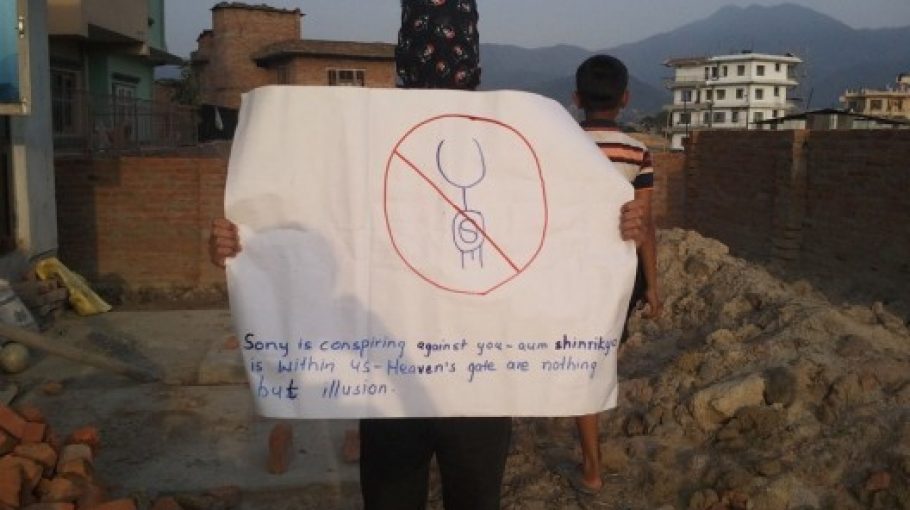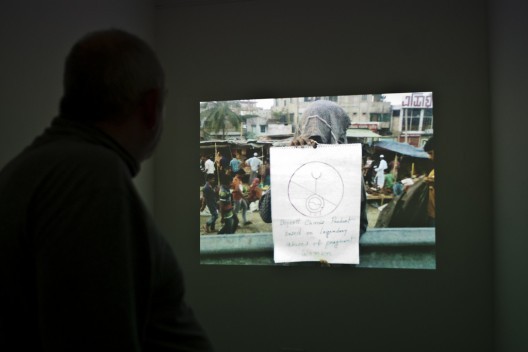Crowdsourcing a conspiracy
Wed 27 Jun 2012IOCOSE’s latest project A Crowded Apocalypse draws on ‘crowdsourcing to hijack the collective imagination’.
It is commissioned by AND Festival and Furtherfield, and is currently being shown at both the Furtherfield Gallery, as part of a group show called Invisible Forces, and online at acrowdedapocalypse.com.
Marc Garrett – co-director & co-founder of Furtherfield, artist, writer, curator and activist – spoke with IOCOSE about the project.
“Our social, economic and cultural institutions are being dismantled. Control over the provision of social care, urban and rural development, and education is being ceded to the market facilitated by unseen technological and bureaucratic systems. By naming, revealing, tracking, playing, making, subverting and transforming tools, circumstances and figures that give rise to current crises we enlarge the debate and extend our freedoms.”
– Invisible Forces, exhibition text
A Crowded Apocalypse is a net art project that exploits crowdsourcing tools to simulate a global conspiracy. The work exploits the fertility of network culture as a ground for conspiracy theories which, in common with many advertisements, are persuasive but are neither ultimately provable or irrefutable. How do you consider this piece relates to the larger theme of Invisible Forces?
Conspiracy theories usually assume the presence of an invisible force, of someone or something plotting in the shadows. The resulting theories are precisely concerned with the reasons and motivations which lie behind the facade, hidden from the surface level impression intended to mislead the victims.
Crowdsourcing instead is explicit in its mechanism. The micro-contracts established between ‘employer and employee’ display clear requests, in terms of working time required and amount of money to be expected for the completion of the job.
However, there is an invisible element in crowdsourcing, which is the ‘bigger picture’, the final plan, the reason which makes that micro-work valuable for someone else. While conspiracy theories are entirely based on the obsession for this missing pieces, crowdsourcing is based on a lack of information, which is not considered relevant. The job has to be mechanical, not biased by unnecessary information. Invisible forces, or the lack thereof, seem to frame these two (apparently unrelated) concepts.
You use crowdsourcing techniques to realize the project. A process that involves outsourcing tasks to a distributed group of people. How did you set it all up, and what were the reasons for using this process?
We have been using different online services. The most famous of them, Amazon Mechanical Turk, is not available outside the USA and India, so we had to rely on other services. The crucial part of the work has been the database which we set up at the beginning to collect and archive the received jobs. No need to say that probably a good 70% of what we received was absolute crap, which did not respect what we required, or were failed attempts to earn $0.10 in less than one minute.
Crowdsourcing can deploy workers both online and in physical environments. What aspects of the project involved individuals working offline and what did they do? What elements of the project did they create themselves?
It is actually quite unusual for them to work offline, as we asked them to do. At the final stage we wanted them to go out in the street and take a picture of themselves. It was precisely this unusual effect that we wanted to achieve. We asked them to write a slogan on a piece of paper and go in the street, as if they were protesting or informing the passers-by of the conspiracy.
However, the conspiracy and the slogans were all generated through crowdsourcing. They were not required to commit to the cause, to become activist, but simply to fulfill a mechanical job, as it happens in crowdsourcing. The streets, the public space, remained a completely disembodied space, neutral. The workers were not aware and not interested in the consequences or in the reasons (the ‘invisible forces’) behind their activity.
How many people got involved and which countries did they come from?
We estimate several thousands, mostly from Asian countries and Eastern Europe. It is quite interesting to notice how crowdsourcing replicates the geographical distribution of the previous systems of outsourcing. Crowdsourcing was not intended, at least in its most enthusiastic narratives, to be a system for gathering cheap labour, but to reward the fragmented free time of qualified workforce. Yet, it seems to work mostly where $1 is still a valuable income.
This work appears to connect to the themes you were exploring with your exhibition at the Tate Modern Sunflower Seeds On Sunflower Seeds (2011). Are you interested in the questions surrounding the relationship between the workers and the artwork?
By claiming the authorship of both works we do not intend to overlook the concept of authorship, but rather to further reflect on it. Sunflower Seeds On Sunflowers Seeds was mostly based on Ai Weiwei’s work, which was in its turn based on the work of a large number of artisans. With our intervention we remarked both the necessity of ‘authorship’ in contemporary art and the fragility of the concept.
In A Crowded Apocalypse we have been the ‘Ai Weiwei’, in a certain sense, as we have in fact commissioned a multitude of molecular, meaningless pieces, which all together came to constitute the project. It was not in our intentions to dismiss the concept of authorship, but to articulate, in both projects, to which extent this is still key in framing the ways we think about the production of art. If there is a similarity (and we believe there can be even more than one) is in the attempt to expand the concept of authorship without falling in the temptation of being merely oppositional to it.
In this piece the ‘crowd’ assembles its own conspiracy and then protests against its protagonists and effects. Do you anticipate that A Crowded Apocalypse will succeed in introducing to the world new conspiracy memes?
This might be the case, although we should not be too naive in this.
The conspiracies we have generated are completely deprived of the political investigation which encourages some (maybe only a few) of the conspiracy theorists out there.
The workers, commissioned through a crowdsourcing platform, are given exact instructions on what to do, and are not required to commit to the cause. They are instead rewarded with a small amount of money (from $1 to $3 max.). There is no ‘ethos’ in the action of the net-workers. While reducing themselves to ‘artificial intelligence’ (as Amazon Mechanical Turk defines crowdsourcing) they transform a practice of activism into a mechanical process.
The result is a collection of singular, anonymous protests, which slogans and claims, generated through a series of fragmented tasks, barely makes sense. The workers, and the people around them, appear at the same time as victims and beneficiaries, actors and spectators of network technologies.
As such, we can imagine their images to become a ‘meme’, as it happened for example to our previous project Game Arthritis or Sokkomb, where the pictures have widely circulated outside of the original context we proposed. They could also become generative of actual protests. We can’t foresee what is going to happen. However, in the context of A Crowded Apocalypse, the people we have involved are not protesters. They are workers.
What does ‘A Crowded Apocalypse’ tell us about contemporary life?
Well, the idea was precisely to do the work, so that we could know from audience and critics what does it say about contemporary life. We can’t do it all ourselves. Should we maybe crowdsource the answer?
A Crowded Apocalypse is commissioned by AND Festival and Furtherfield. The Invisible Forces exhibition is on at the Furtherfield Gallery, London until 11 Aug 2012.

